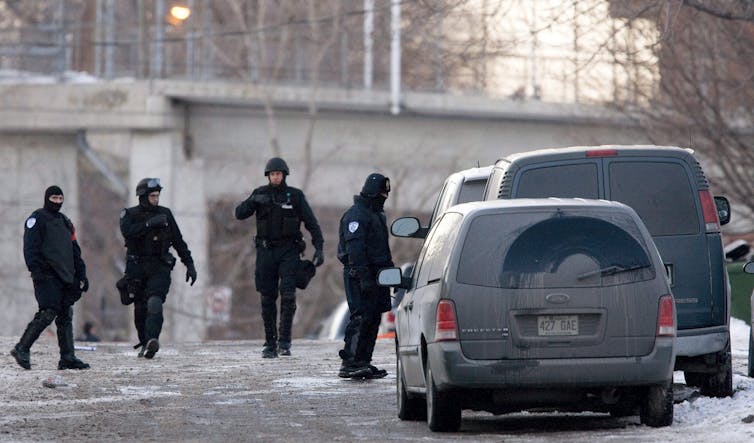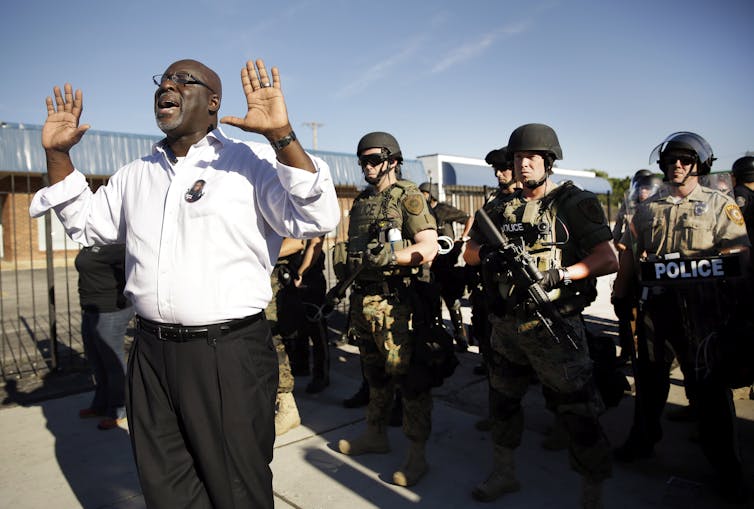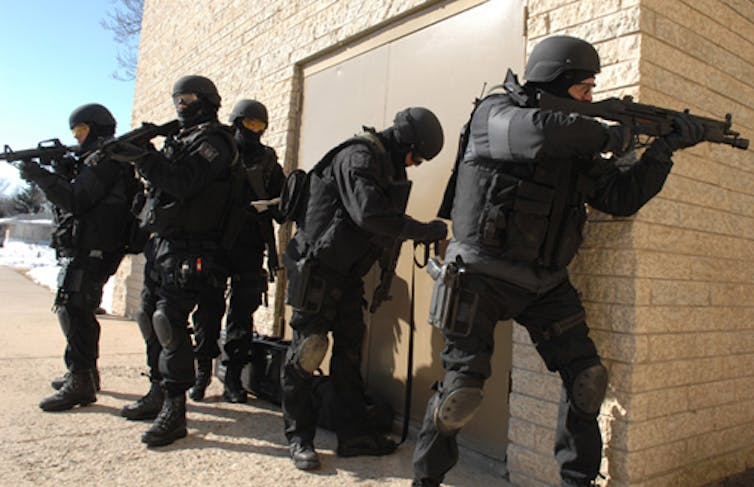Rise of the SWAT team: Routine police work in Canada is now militarized

The militarization of United States police forces has received a lot of attention in recent years, especially after high profile incidents in places like the Missouri town of Ferguson and other police shootings across the U.S.
Scholars have tended to focus on these U.S. shootings, overlooking Canadian cases when forming their understanding of the issue. But without Canadian-focused data and research, we’re at risk of overlooking the massive militarization that has been occurring among Canada’s major police forces.
Our research examines militarization within Canadian police forces over the last decade. With 12 cities that are home to more than 500,000 people, and at least 22 police services that each employ 500 or more officers, it’s important to look at policing trends in Canada’s major urban centres.
We studied 10 large and medium-sized Canadian police forces, comprising eight municipal police forces, one provincial police force and one federal police force from across seven different provinces. Using freedom-of-information (FOI) requests, we obtained data on the operational dimensions of SWAT team use.
Deployments of SWAT teams — special weapons and tactics units — have risen in major Canadian cities and are higher in some cases than those by U.S. public police. Based on our research, we can see that militarization has been normalized within Canada’s largest police services. SWAT teams, once considered a last-resort option for police forces, are now being used in routine areas of policing.

2,100 per cent increase in SWAT deployments
The most substantial finding is the enormous rise in the average number of deployments by tactical units. In 1980, the average yearly number of deployments for Canadian tactical units was about 60 total per unit. Our results show the average yearly number of deployments for Canadian tactical units is now approximately 1,300 per unit, an increase of roughly 2,100 per cent in 37 years.Even among SWAT teams whose deployments have decreased at some point in the last five years, none that we looked at saw similar decreases to their number of assigned officers. So while their deployments may have decreased, the size of their teams have not.
As criminologist Peter Kraska has argued, the paramilitary subculture embraced by SWAT teams is influential on police officers, and tricky to scale back once normalized.
In Canada, there is no national policy or law regulating SWAT team conduct or growth. Therefore it’s no surprise we found that figures for SWAT team deployments are not monolithic.
What the numbers say
Though SWAT team deployments in Vancouver and Ottawa generally fluctuated between 100 and 200 times each year, they deployed fewer times than teams in other jurisdictions.Deployments of other SWAT teams were higher in number. The FOI requests showed that the Ontario Provincial Police’s (OPP) Emergency Response Team (ERT) and the Winnipeg Police Service’s (WPS) Tactical Support Team (TST) deployed at their their highest rates in 2016, with more than 2,000 and 3,000 deployments respectively.
The information provided by the OPP further revealed that their tactical force has consistently deployed at just under 1,900 times to somewhat over 2,000 times each year since 2007.
Deployment statistics extrapolated from the Winnipeg force’s daily occurrence reports revealed almost 500 deployments of their SWAT team in 2013 and almost 3,400 in 2016. While this appears to suggest an extraordinary increase, we believe that this reflects a limit of the data, and that Winnipeg’s TST was deployed far more frequently in 2013 than is suggested by the report.
Deployments of the Calgary Police Service’s (CPS) Tactical Unit revealed a somewhat unique case in our research. Although the unit deployed at a similarly high rate to those of the OPP and Winnipeg in 2007, its deployments declined in each examined year to just over 600 in 2016.
Drug warrants, suspicious incidents, traffic violations
If SWAT team deployments were limited to only those situations requiring their equipment and skills, such as hostage-takings and terror threats, there would perhaps be less cause for concern. But similar to previous research conducted in the U.S., we have found this isn’t the reality of Canadian SWAT teams. Instead, routine policing represented the majority of SWAT team use.SWAT teams are increasingly being used by public police for routine activities such as executing warrants, traffic enforcement, community policing and responding to mental health crises and domestic disturbances.
The consequences of militarization fall disproportionately on minority groups, those with mental health issues and those exercising democratic rights associated with political expression.
Canadian police forces have been largely silent on the expansion of their SWAT teams, though some have suggested the expansion produces greater value to taxpayers. Meanwhile, SWAT team budgets climb ever higher as their use expands.
Despite the overall decline in the Calgary tactical unit’s deployments by 2016, almost one third of them were for warrants, which remained steady at around 200-250 instances per year.
The Ottawa Police Service tactical unit executed approximately 100 warrants each year, about 70 per cent of the unit’s total deployments, a large proportion drug-related.
The Winnipeg unit executed almost 250 warrants in 2016, less than in 2013, yet more than most other SWAT teams. Warrant work did not make up a large proportion of deployments for either the OPP’s tactical unit or Winnipeg’s, though it was noticeable.
SWAT teams regularly engage in routine policing, including responding to minor offences or even non-criminal incidents. The Calgary tactical unit deployed almost 300 times in response to various “dispatch codes” in 2007, as well as approximately 200 times each to “disturbances” and “suspicious” incidents.
Deployments in these three categories accounted for nearly 45 per cent of the unit’s total deployments during that year, and continued to represent as much as 30 per cent by 2016.

Deployments for other minor offences, including noise complaints, drug offences, property crimes, traffic violations and motor vehicle collisions represented almost one third of all deployments in 2007, and almost 15 per cent even at their lowest point in 2016.
Winnipeg has high deployments
The Winnipeg tactical unit was the most engaged in community policing. Nearly 100 instances of “special attentions” or “hot spot” deployments by the tactical support team are recorded in the 2016 daily occurrence report, as well as a substantial number of deployments in response to noise complaints, traffic incidents and disturbances.SWAT team deployments in response to individuals with mental health issues, suicide threats and well-being checks were also common. The Calgary tactical unit was called to more than 130 incidents in 2007; while decreasing each year, the unit still responded to more than 60 such incidents in 2016.
By contrast, the Winnipeg tactical unit has responded to an increasing number of incidents. There were fewer than 20 suicide threats and well-being checks recorded in the 2013 daily occurrence report; in the 2016 report, there were almost 300 such deployments.
Some entries included notes that provided insight into the Winnipeg unit’s strategy for handling such occurrences that involved confronting suicidal individuals and gaining their compliance.
Although the OPP’s tactical unit responded to few calls of this nature, it responded similarly by assisting street-level officers in bringing individuals with known or suspected mental health issues into custody on several occasions.
Given that SWAT teams are the most heavily armed and armoured police units, it is concerning that they have a significant role in responding to individuals suffering from mental health issues.
Future for policing in Canada?
While Peter Kraska found that deployments of American SWAT teams in the 1980s and ‘90s were increasing each year,, the deployment data for Canadian SWAT teams shows a less steady rise. This should not be taken to mean that SWAT teams do not play an active role in policing in Canada, or that Canadian police forces are not becoming militarized.The Canadian SWAT teams in this research have consistently deployed at a higher rate than was observed by Kraska and Victor Kappeler of urban SWAT teams at their highest point in the 1990s.
More significant is that there was strong evidence suggesting Canadian SWAT teams are routinely being used in reactive and proactive work that falls outside their intended function — and frequently outside of what is revealed to the public.
In some cases, the most notable being Winnipeg’s tactical unit, the findings show SWAT teams are being used in routine patrol work and as part of their police service’s community policing strategy. The involvement of SWAT teams in such activities highlights their expanding role in policing, suggesting a high degree of normalization which is indicative of militarization.
There is no meaningful oversight for normalization and expansion of police militarization across the U.S. and our findings suggest a similar case in Canada.
Militarization does not merely affect interactions between the state and criminal offenders, it changes what policing is by changing what police officers do.
The financial and social costs of using SWAT teams are also concerning. Their use in routine policing, and even in warrant execution, should be declared a failed public policy and scaled back immediately.
Kevin Walby, Associate Professor of Criminal Justice, University of Winnipeg and Brendan Roziere, Law student, Robson Hall, University of Manitoba
This article is republished from The Conversation under a Creative Commons license. Read the original article.
No comments:
Post a Comment